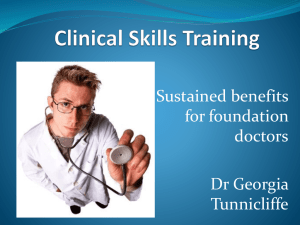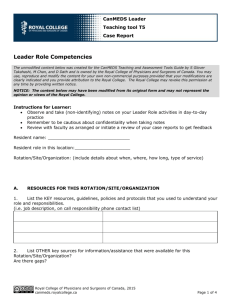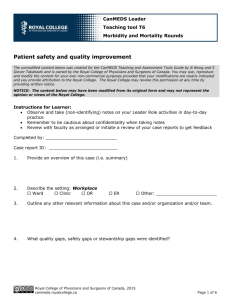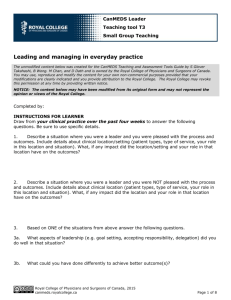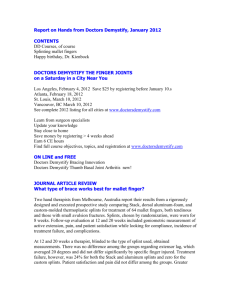Communicator - Faculty of Health Sciences
advertisement
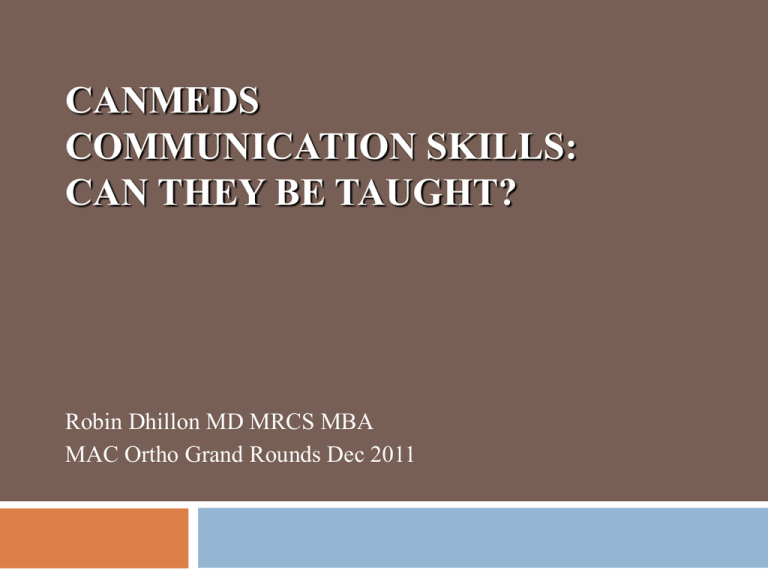
CANMEDS COMMUNICATION SKILLS: CAN THEY BE TAUGHT? Robin Dhillon MD MRCS MBA MAC Ortho Grand Rounds Dec 2011 Acknowledgement Materials provided by the CANMEDS Train-the-trainer program, Royal College of Physicians and Surgeons Lara Cooke – Calgary Sue Dojeiji – Ottawa Suzanne Kurtz – Washington Toni Laidlaw - Halifax Copyright © 2006 The Royal College of Physicians and Surgeons of Canada. http://rcpsc.medical.org/canmeds. Reproduced with permission Objectives To review the evidence supporting the benefits of communication skills teaching To introduce some strategies for teaching communication skills To introduce some strategies for evaluating communication skills WHY TEACH COMMUNICATION SKILLS? Communication is a core clinical skill Competency required by all medical licensing bodies Estimated 200,000 consultations in a professional lifetime Copyright © 2006 The Royal College of Physicians and Surgeons of Canada. http://rcpsc.medical.org/canmeds. Reproduced with permission COMMUNICATION PROBLEMS EXAMPLES OF COMMUNICATION PROBLEMS Approximately ¼ of patients complete their opening statement Average time for patient to complete opening statement = 36 seconds “Whoa - way too much information!” EXAMPLES OF COMMUNICATION PROBLEMS Doctors frequently interrupt patients Average time before interruption Attending = 19- 24 seconds Resident = 12 seconds “We’re running a little behind, so I’d like each of you to ask yourself, ‘Am I really that sick, or would I just be wasting the doctor’s valuable time?’” EXAMPLES OF COMMUNICATION PROBLEMS Doctors often pursue a ‘doctor-centered,’ closed approach to information gathering “Ah, Mr. Bromley. Nice to put a face on a disease.” EXAMPLES OF COMMUNICATION PROBLEMS Doctors provide less information to patients than patients want One quarter to one third of patients report receiving less information than they want “There’s no easy way I can tell you this, so I’m sending you to someone who can.” EXAMPLES OF COMMUNICATION PROBLEMS Doctors often use language that patients don’t understand Doctors rarely ask their patient to volunteer their ideas and often inhibit their expression “Let the healing begin!” EXAMPLES OF COMMUNICATION PROBLEMS Doctors overestimate the time given to explanation and planning “It’s your ear, nose and throat.” EXAMPLES OF COMMUNICATION PROBLEMS Patient non-adherence is expensive $7 – $9 BILLION dollars per year in Canada “Give it to me straight, Doc. How long do I have to ignore your advice?” EXAMPLES OF COMMUNICATION PROBLEMS Numerous reports of patient dissatisfaction with the patient/doctor relationship A large percentage of malpractice suits result from poor communication 2010 CMPA Annual Report “The doctor is in court on Tuesdays and Wednesdays.” ACCREDITING BODIES NOW REQUIRE COMMUNICATION TEACHING FOR ACCREDITATION OF RESIDENCY PROGRAMS Royal College of Physicians and Surgeons of Canada (CanMEDS 2000 & Phase IV, 2005) Accreditation Council for Graduate Medical Education (2002) Royal College of General Practitioners (UK, 2004) COMPARATIVE STUDY OF 9 URBAN HOSPITALS RE: JOINT REPLACEMENT SURGERY Some invested heavily in hiring and training for relational competence (ie, ability to interact with others to accomplish goals) Others looked for most highly qualified individuals (neglect of relational competence most pronounced in physician hiring) Significant differences were found between hospitals re levels of coordination among care providers Hoffer Gittel J 2003, Hoffer-Gittel et al 2000 9 HOSPITAL COMPARATIVE STUDY Higher coordination between care providers significantly improved patient care. Eg, increase in coordination enabled: 31% reduction in length of stay 22% increase in pt perceived quality of care 7% increase in postoperative relief from pain 5% increase in postoperative mobility Hoffer Gittel 2003, Hoffer-Gittel et al, 2000 9 HOSPITAL COMPARATIVE STUDY Conclusion: “…those in positions that require high levels of functional expertise also tend to need high levels of relational competence to integrate their work with others.” Hoffer-Gittel et al 2000 “It’s not just individual brilliance that matters anymore. It’s coordinated effort.” Participant in Hoffer-Gittel et al 2000 study Research Findings - EVIDENCE…. Enhancing communication leads to better outcomes: understanding & recall symptom relief adherence & concordance physiological outcomes patient safety patient satisfaction doctor satisfaction costs complaints and malpractice litigation THE BENEFITS OF GOOD COMMUNICATION For the physician: alleviation of burnout and stress reduced frequency of malpractice complaints satisfaction So….. Now that we understand the skill is important, how do we teach AND practice it? OVERALL GOAL OF ALL COMMUNICATION TEACHING AND LEARNING Improving communication in practice to a professional level of competence • • Behavior = what we do anyway vs Professional competence = awareness & attention intentionality ability to reflect on & articulate and it’s evidence based 2 ESSENTIAL CONTEXTS FOR COMMUNICATION TEACHING Formal curriculum Dedicated communication sessions, modules Informal curriculum ‘In-the-moment’ teaching (follow-through in clinic, hospital, and other real world contexts) Modeling (intentional and unintentional) ‘Hidden’ curriculum of how students are treated and see us treating others WHAT IT TAKES TO LEARN COMMUNICATION SKILLS, CHANGE BEHAVIOR Essentials needed: systematic delineation & definition of skills observation of learners with patients (video) well-intentioned, detailed, descriptive feedback (reflection) practice and rehearsal of skills (SP’s, volunteers) planned reiteration and deepening of skills Small group or one-on-one learning format Incorporation of research, cognitive and attitudinal material INFORMAL CURRICULUM PROVIDES FOLLOW THROUGH IN REAL LIFE (or not) To reinforce and deepen previous learning To validate applicability in the ‘real world’ To learn new skills To learn to apply skills & capacities in increasingly complex situations To move toward professional level of competence WHY ARE COMMUNICATION PROCESS SKILLS SO ADAPTABLE? Context changes Content changes Levels of intensity, intention, & awareness shift BUT Communication process skills remain the same from year 1 through clerkship, postgraduate, CME TYPES OF COMMUNICATION SKILLS Content skills - what you say Process skills - how you communicate - how you structure interaction - how you relate to patients - nonverbal skills Perceptual skills - what you are thinking - what you are feeling - medical problem solving - attitudes, assumptions, intentions, biases - capacities (compassion, mindfulness) MODELLING IS FUNDAMENTAL TO SUCCESS OF FORMAL COMMUNICATION PROGRAMS Students of medicine learn first and foremost from what they see and experience, rather than from what’s written in the syllabus… Suchman and Williamson, 2003 WHAT ARE WE MODELLING? Skills* Attitudes, beliefs, values Capacities (eg, compassion, integrity, flexibility, mindfulness) In what contexts? Difficult situations (complex case, breaking bad news, death and dying, medical error, adverse outcomes) Everyday run-of-the-mill consultations, patient education and prevention Same focus as in formal curriculum WHAT ARE WE MODELLING? How we use communication skills and relational competencies with patients How we interact with other professionals and support staff How we treat the learners themselves What we choose to focus on and discuss with learners during rounds & in clinical settings MODELLING THAT OVERIDES EFFECTIVE COMMUNICATION ‘Forget that open-ended stuff - we’ll be here all day if you start there. Just follow the questions I gave you…’ ‘Forget about the patient’s problem list - we don’t deal with all of that. Just go for the chief complaint…’ ‘Don’t give me that patient perspective mumbo jumbo - I just want to know “the facts”…’ MODELLING TO ADVANTAGE - CHALLENGES Junior doctors’ being there to observe Inconsistent modelling - some good, some not Residents identified few role models for communication and relational competence Infrequency of ‘deliberate’ modelling Talking about communication in a structured way ‘Modelers don’t know how to make skills explicit’ Hesitancy to talk about communication, what’s good Residents can come up with ‘gestalt’ of what role models are doing, but don’t see how you do it TAUGHT SKILL RETENTION VS DEVELOPMENT WITH EXPERIENCE ALONE Doctors 5 years out of medical school still strong in information gathering (taught) but weak in explanation and planning skills (experience only) discovering pt’s views/expectations - 70% no attempt negotiation - 90% no attempt encouraging questions - 70 % no attempt repetition of advice - 63% no attempt checking understanding - 89% no attempt categorizing information - 90% no attempt Maguire et al 1986 DIFFICULTIES OF WORKING IN-THE-MOMENT Achieving satisfactory re-rehearsal Obtaining feedback from patients Discussing sensitive issues in front of patients Availability of time (patients’ and clinicians’) Multiplicity of tasks (including patient care) Wide range of teaching agendas EXAMPLES OF POSTGRADUATE MODELLING TO ADVANTAGE During surgical rounds senior surgeon asked for 2 additional pieces of information after learner’s presentation of patient: ‘What questions will this patient want me to answer?’ ‘What concerns does this patient have that I need to address?’ During bedside teaching, an internal medicine staff doctor explicitly distinguished between teaching about problem solving and patient care Endocrinologist focused attention on what he wanted junior doctors to emulate Asked questions about communication just as he did about PE or medical problem solving or medical technical knowledge Reflected on what he was doing often Thought out loud, invited learners to think with him Talked about his own errors or mistakes and how he handled them MORE EXAMPLES OF POSTGRADUATE MODELLING TO ADVANTAGE Nephrologist invited junior doctors to do a video review focusing on his communication skills with a patient Director of orthopedic surgery residency program invited a communication specialist and residents to do a ‘roast’ focused on how he communicated with patients Director of anesthesiology residency program developed a version of the Calgary-Cambridge Guides for pre-op interaction with patients and included it in the daily faculty evaluation protocol for residents (she saw changes in both faculty and residents, as a result) When consultations went badly, a senior oncology surgeon read through the C-C pocket guide to review what he might have missed re communication skills AND MORE EXAMPLES General practice doctor joined forces with an oncologist and a simulated patient to organize and facilitate lunchtime ‘improve’ simulations based on residents’ current communication dilemmas Family medicine doctor initiated monthly ‘communication rounds’ for cross specialty training Instead of just discussing, senior doctor demonstrated alternative approach in mini-simulation away from the patient or with the real patient; asked learners to do same Junior doctors modeled effective communication and relational competencies with medical students and then asked questions, talked about it. Information Transfer To improve patient adherence, outcome and patient satisfaction: Clear information Easy to understand No medical jargon Mutual expectations Active patient role Non-verbal communication Information Transfer To improve understanding and recall: Categorization Sign-posting Summarizing Repetition Diagrams Write it down Information Transfer Categorization “We have 3 ways to manage your mild carpal tunnel syndrome; first is a night-time splint; second is an anti-inflammatory; third is a cortisone injection” “Lets talk about the splint…” Information Transfer Signposting “We’ve talked about the splint (option 1), lets talk about the anti-inflammatory (option 2)…” Information Transfer Summarizing “So again, the options are the splint, the medication and the cortisone injection” “What do you think of those options?” Information Transfer Repetition Either you or the patient repeats at the end of the interview Can aid recall by 30% “So what are those things we’re going to do for the carpal tunnel syndrome again? Information Transfer Write it down Good strategy for complex plan Good strategy if cognition a concern Good if you’re explaining a procedure to the patient – they can keep the picture for reference and questions Information Transfer Diagram “Here’s a picture of your hand looking at your palm. These are muscles and bones. Here is the nerve that going from your forearm to your hand. It goes through a tunnel made of bone …” Assessing Communication Skills Experiences so far Verbal communication Challenges Written communication Successes – please share! Barriers Steps for Assessment 1. Choose an assessment tool 2. Learn to use the assessment tool 3. Review methods for ALOBA 4. Evaluation and feedback “blueprint” 1. Choose an assessment tool Defines the objectives Curriculum Evaluation Skills based Validated Examples of Communication Assessment Tools Calgary Cambridge Observation Guide Kalamazoo Checklist Brown Interview Checklist SEGUE Framework CALGARY-CAMBRIDGE GUIDES FRAMEWORK FOR THE MEDICAL CONSULTATION Initiating the Session Providing Structure Gathering Information Building the Relationship Physical Examination Explanation/Planning Closing the Session Kurtz, Silverman, Draper (2005) ADVANTAGES OF C-C GUIDES Accessible summary of skills - validated Framework for systematic skill development Memory aid to keep skills in mind, organized Basis for comprehensive feedback (no hit and miss) – consistency across groups Common foundation for programs at all levels – basis for helical, coherent curricula Learners know what’s on the exam get go Guidance with considerable latitude Same guide = skills for communicating with patients, colleagues, learners 2. Learn to use the tool Read it Train your assessors (faculty) Review skills with trainees Elicit the skills Video and discussion 3. Giving feedback - ALOBA 4. Evaluation and feedback “blueprint” Outline your curriculum and feedback process Link your objectives with your assessment Choose your assessment methods Remember… What are you trying to measure OSCE with SP Objective structured clinical examination Standardized patient Assessment under controlled settings Difficult, infrequent or sensitive communication Components can be evaluated e.g., Explanation and planning Feedback provided by examiner and/or SP Formative and summative Multiple source feedback Increasingly being used Multiple raters Patients, other health professionals, peers Can be an onerous process Get information on what you don’t see Prime team members early on Portfolios and logbooks Track ongoing learning of communication competencies Very good for written communication skills Discharge summaries Consultation letters Operative reports Promote reflection on practice Tool for self-directed enhancement Potential for misrepresentation IN CLOSING Communication skills in medicine are more than a “toolbox” of devices. Rather, they are a means of developing dialogue and rapport with patients that enhance human connection. This human connection is integral in maintaining joy in practice.



